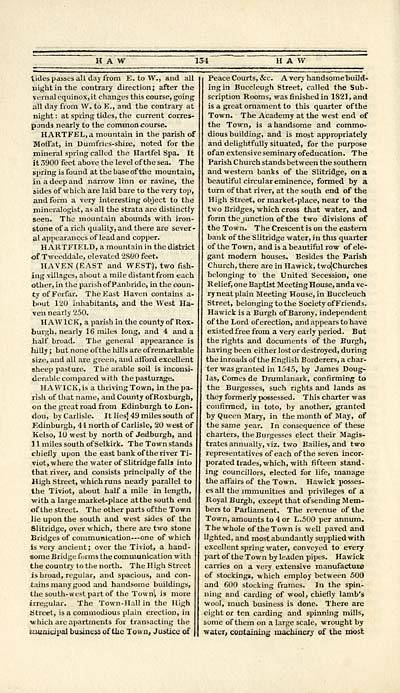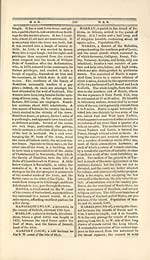Gazetteer of Scotland
(136) Page 134
Download files
Complete book:
Individual page:
Thumbnail gallery: Grid view | List view

HAW
'tides passes all day from E. to IV., and all
night in the contrary direction; after the
vernal equinox, it changes this course, going
all day from W. to E., and the contrary at
night : at spring tides, the current corres-
ponds nearly to the common -course.
HARTFEL, a mountain in the parish of
Moffat, in Dumfries-shire, noted for the
mineral spring called the Hartfel Spa. It
it 3900 feet above the level of the sea. The
spring is found at the base of tile mountain,
in a deep and narrow linn or ravine, the
sides of which are laid bare to the very top,
and form a very interesting object to the
mineralogist, as all the strata are distinctly
seen. The mountain abounds with iron-
stone of a rich quality, and there are sever-
al appearances of lead and copper.
H ARTFIELD, a mountain in the district
of Tweeddale, elevated 2S00 feet.
HAVEN (EAST and WEST), two fish-
ing villages, about a mile distant from each
other, in the parish of Panbride, in the coun-
ty of Forfar. The East Haven contains a-
bout 120 inhabitants, and the West Ha-
ven nearly 250.
H AW 1CK, a parish in the county of Rox-
burgh, nearly 16 miles long, and 4 and a
half broad. The general appearance is
hilly ; but none of the lulls are of remarkable
size, and all are green, and afford excellent
sheep pasture. The arable soil is inconsi-
derable compared with the pasturage.
HAWICK, is a thriving Town, in the pa-
rish of that name, and County of Roxburgh,
on the great road from Edinburgh to Lon-
don, by Carlisle. It liesj 49 miles south of
Edinburgh, 44 north of Carlisle, 20 west of
Kelso, 10 west by north of Jedburgh, and
11 miles south of Selkirk. The Town stands
chiefly upon the east bank ofthe river Ti-
viot, where the water of Slitridge falls into
that river, and consists principally of the
High Street, which runs nearly parallel to
the Tiviot, about half a mile in length,
with a large market-place at the south end
of the street. The other parts ofthe Town
lie upon the south and west sides of the
Slitridge, over which, there are two stone
Bridges of communication— one of which
is very ancient; over the Tiviot, a hand-
some Bridge forms the communication with
the country to the north. The High Street
is broad, regular, and spacious, and con-
tains many good and handsome buildings,
the south-west part of the Townl, is more
irregular. The Town-Hall in the High
Street, is a commodious plain erection, in
which arc apartments for transacting the
uumiupal business of the Town, Justice of
4 HAW
Peace Courts, &c. A very handsomebuild-
ingin Buccleugh Street, called the Sub-
scription Rooms, was finished in 1821, and
is a great ornament to this quarter ofthe
Town. The Academy at the west end of
the Town, is a handsome and commo-
dious building, and is most appropriately
and delightfully situated, for the purpose
of an extensive seminary of education. The
Parish Church standsbetween the southern
and western banks of the Slitridge, on a
beautiful circular eminence, formed by a
turn of that river, at the south end of the
High Street, or market-place, near to the
two Bridges, which cross that water, and
form thejunction ofthe two divisions of
the Town. The Crescent is on the eastern
bank ofthe Slitridge water, in this quarter
of the Town, and is a beautiful row of ele-
gant modern houses. Besides the Parish
Church, there are in Hawick, twojChurches
belonging to the United Secession, one
Relief, one Baptist Meeting House, anda ve-
ry neat plain Meeting House, in Buccleuch
Street, belonging to the Society of Friends.
Hawick is a Burgh of Barony, independent
ofthe Lord of erection, and appears to have
existed free from a very early period. But
the rights and documents of the Burgh,
having been either lost or destroyed, during
the inroads ofthe English Borderers, a char-
ter was granted in 1545, by James Doug-
las, Comes de Drumlanark, confirming to
the Burgesses, such rjghts and lands as
they formerly possessed. This charter was
confirmed, in toto, by another, granted
by Queen Mary, in the month of May, of
the same year. In consequence of these
charters, the Burgesses elect their Magis-
trates annually, viz. two Bailies, and two
representatives of each ofthe seven incor-
porated trades, which, with fifteen stand-
ing councillors, elected for life, manage
the affairs of the Town. Hawick posses-
es all the immunities and privileges of a
Royal Burgh, except that of sending Mem-
bers to Parliament. The revenue of the
Town, amounts to 4 or L.500 per annum.
The whole oftheTownis well paved and
lighted, and most abundantly supplied with
excellent spring water, conveyed to every
part ofthe Town by leaden pipes. Hawick
carries on a very extensive manufacture
of stockings, which employ between 500
and 600 stocking frames. In the spin-
ning and carding of wool, chiefly lamb's
wool, much business is done. There are
eight or ten carding and spinning mills,
some of them on a large scale, wrought by
water, containing machinery of the most
'tides passes all day from E. to IV., and all
night in the contrary direction; after the
vernal equinox, it changes this course, going
all day from W. to E., and the contrary at
night : at spring tides, the current corres-
ponds nearly to the common -course.
HARTFEL, a mountain in the parish of
Moffat, in Dumfries-shire, noted for the
mineral spring called the Hartfel Spa. It
it 3900 feet above the level of the sea. The
spring is found at the base of tile mountain,
in a deep and narrow linn or ravine, the
sides of which are laid bare to the very top,
and form a very interesting object to the
mineralogist, as all the strata are distinctly
seen. The mountain abounds with iron-
stone of a rich quality, and there are sever-
al appearances of lead and copper.
H ARTFIELD, a mountain in the district
of Tweeddale, elevated 2S00 feet.
HAVEN (EAST and WEST), two fish-
ing villages, about a mile distant from each
other, in the parish of Panbride, in the coun-
ty of Forfar. The East Haven contains a-
bout 120 inhabitants, and the West Ha-
ven nearly 250.
H AW 1CK, a parish in the county of Rox-
burgh, nearly 16 miles long, and 4 and a
half broad. The general appearance is
hilly ; but none of the lulls are of remarkable
size, and all are green, and afford excellent
sheep pasture. The arable soil is inconsi-
derable compared with the pasturage.
HAWICK, is a thriving Town, in the pa-
rish of that name, and County of Roxburgh,
on the great road from Edinburgh to Lon-
don, by Carlisle. It liesj 49 miles south of
Edinburgh, 44 north of Carlisle, 20 west of
Kelso, 10 west by north of Jedburgh, and
11 miles south of Selkirk. The Town stands
chiefly upon the east bank ofthe river Ti-
viot, where the water of Slitridge falls into
that river, and consists principally of the
High Street, which runs nearly parallel to
the Tiviot, about half a mile in length,
with a large market-place at the south end
of the street. The other parts ofthe Town
lie upon the south and west sides of the
Slitridge, over which, there are two stone
Bridges of communication— one of which
is very ancient; over the Tiviot, a hand-
some Bridge forms the communication with
the country to the north. The High Street
is broad, regular, and spacious, and con-
tains many good and handsome buildings,
the south-west part of the Townl, is more
irregular. The Town-Hall in the High
Street, is a commodious plain erection, in
which arc apartments for transacting the
uumiupal business of the Town, Justice of
4 HAW
Peace Courts, &c. A very handsomebuild-
ingin Buccleugh Street, called the Sub-
scription Rooms, was finished in 1821, and
is a great ornament to this quarter ofthe
Town. The Academy at the west end of
the Town, is a handsome and commo-
dious building, and is most appropriately
and delightfully situated, for the purpose
of an extensive seminary of education. The
Parish Church standsbetween the southern
and western banks of the Slitridge, on a
beautiful circular eminence, formed by a
turn of that river, at the south end of the
High Street, or market-place, near to the
two Bridges, which cross that water, and
form thejunction ofthe two divisions of
the Town. The Crescent is on the eastern
bank ofthe Slitridge water, in this quarter
of the Town, and is a beautiful row of ele-
gant modern houses. Besides the Parish
Church, there are in Hawick, twojChurches
belonging to the United Secession, one
Relief, one Baptist Meeting House, anda ve-
ry neat plain Meeting House, in Buccleuch
Street, belonging to the Society of Friends.
Hawick is a Burgh of Barony, independent
ofthe Lord of erection, and appears to have
existed free from a very early period. But
the rights and documents of the Burgh,
having been either lost or destroyed, during
the inroads ofthe English Borderers, a char-
ter was granted in 1545, by James Doug-
las, Comes de Drumlanark, confirming to
the Burgesses, such rjghts and lands as
they formerly possessed. This charter was
confirmed, in toto, by another, granted
by Queen Mary, in the month of May, of
the same year. In consequence of these
charters, the Burgesses elect their Magis-
trates annually, viz. two Bailies, and two
representatives of each ofthe seven incor-
porated trades, which, with fifteen stand-
ing councillors, elected for life, manage
the affairs of the Town. Hawick posses-
es all the immunities and privileges of a
Royal Burgh, except that of sending Mem-
bers to Parliament. The revenue of the
Town, amounts to 4 or L.500 per annum.
The whole oftheTownis well paved and
lighted, and most abundantly supplied with
excellent spring water, conveyed to every
part ofthe Town by leaden pipes. Hawick
carries on a very extensive manufacture
of stockings, which employ between 500
and 600 stocking frames. In the spin-
ning and carding of wool, chiefly lamb's
wool, much business is done. There are
eight or ten carding and spinning mills,
some of them on a large scale, wrought by
water, containing machinery of the most
Set display mode to: Large image | Transcription
Images and transcriptions on this page, including medium image downloads, may be used under the Creative Commons Attribution 4.0 International Licence unless otherwise stated. ![]()
| Gazetteers of Scotland, 1803-1901 > Gazetteer of Scotland > (136) Page 134 |
|---|
| Permanent URL | https://digital.nls.uk/97423326 |
|---|

